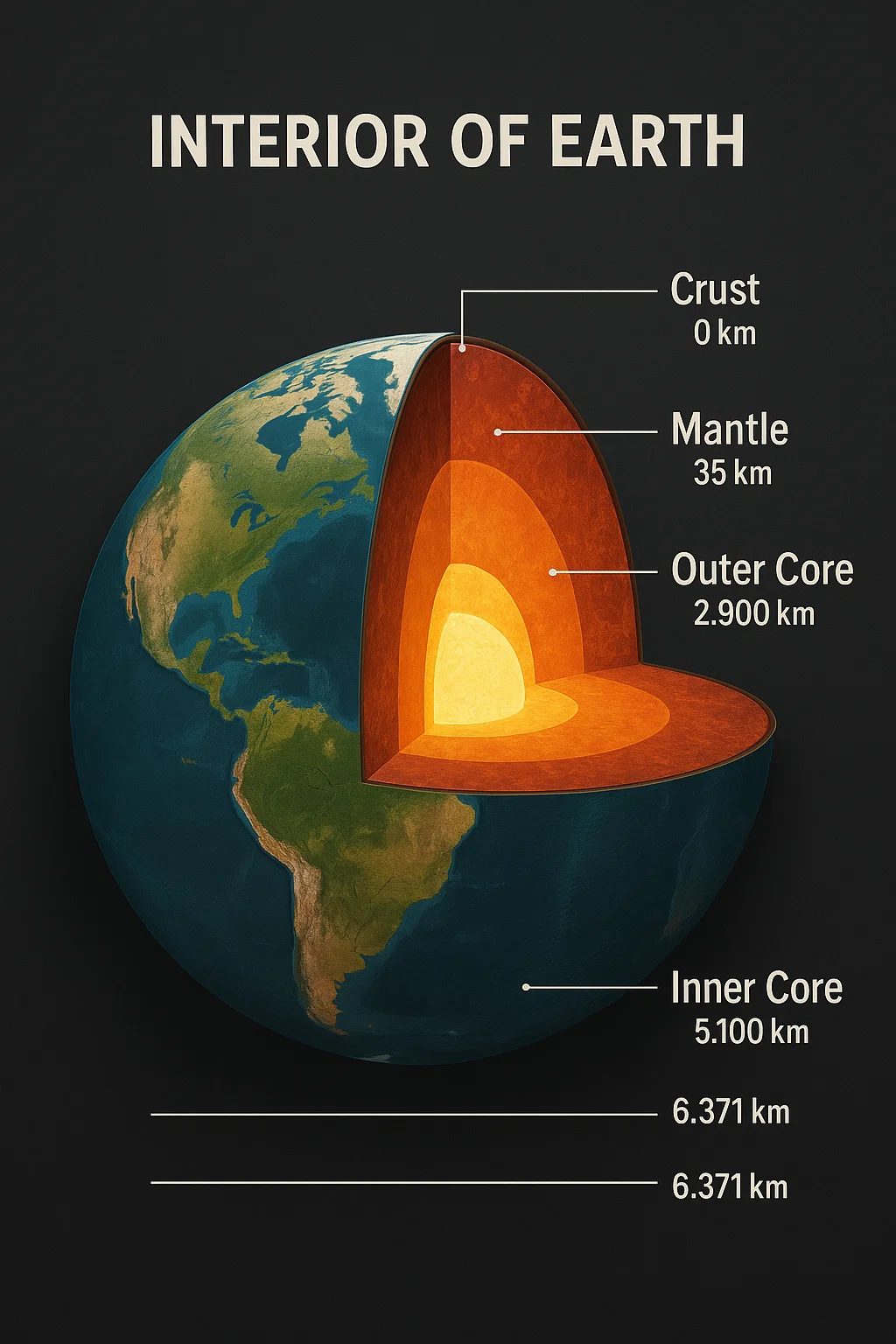
03 Jul Interior of the earth for UPSC
Interior of the Earth – UPSC Geography Notes

Relevant for: UPSC CSE Prelims (Geography) and GS Paper 1 (Mains)
Introduction
The study of the interior of the Earth helps us understand natural phenomena such as earthquakes, volcanoes, plate tectonics, and more. Since direct observation is not possible beyond a few kilometers, scientists rely on indirect sources like seismic data, volcanic material, and meteors.
Sources to Study Earth’s Interior
- Direct Sources: Mining and deep drilling (Kola Superdeep Borehole, ~12 km deep)
- Indirect Sources:
- Seismic waves (P-waves and S-waves)
- Meteorites (nickel-iron composition)
- Volcanic eruptions (magma from mantle)
- Gravitational and Magnetic field data
Layers of the Earth
1. Crust
- Outermost solid layer
- Continental Crust: 30-70 km thick; granitic (sial)
- Oceanic Crust: ~5 km thick; basaltic (sima)
- Density: 2.7 g/cm³ (continental), 3.0 g/cm³ (oceanic)
2. Mantle
- Lies below the crust (~2900 km thick)
- Upper Mantle: Includes Asthenosphere (plastic, semi-molten)
- Lower Mantle: More rigid and denser
- Main elements: Magnesium, iron, silicates
- Density: ~3.3 to 5.5 g/cm³
3. Core
- Also known as Barysphere
- Outer Core: Liquid (generates Earth’s magnetic field)
- Inner Core: Solid (iron and nickel)
- Depth: 2900 km to 6371 km
- Temperature: Up to 6000°C
- Density: ~9.5 to 13 g/cm³
Discontinuities within the Earth
| Discontinuity | Between | Description |
|---|---|---|
| Mohorovičić (Moho) | Crust and Mantle | Identified by a sudden increase in seismic velocity |
| Repetti | Upper and Lower Mantle | Less clearly defined |
| Gutenberg | Mantle and Core | P-waves slow down, S-waves disappear (liquid core) |
| Lehmann | Outer Core and Inner Core | Inner core is solid; discovered by Inge Lehmann |
Seismic Waves and Earth’s Interior
Seismic waves generated by earthquakes provide crucial data about the interior:
- P-waves (Primary): Travel through solids and liquids; fastest
- S-waves (Secondary): Travel only through solids; stop at outer core
- Shadow Zones: Help identify the liquid outer core (S-waves don’t reach)

Composition of Earth’s Interior
- Crust: Oxygen, Silicon, Aluminium, Iron, Calcium
- Mantle: Silicate minerals rich in Mg and Fe
- Core: Iron (Fe) and Nickel (Ni) – called NIFE
Importance for UPSC Exam
- Frequently asked in UPSC Prelims
- Helps in understanding related topics: Plate tectonics, Earthquakes, Volcanoes
- Static portion of Geography – high return for effort
Sample UPSC Prelims MCQs
- Which seismic waves can travel through both solids and liquids?
A. P-waves - The Moho discontinuity separates:
C. Crust and Mantle - Which part of the Earth is responsible for generating the magnetic field?
D. Outer Core
Summary
- The Earth is made up of three main layers: Crust, Mantle, and Core.
- Seismic waves are the most reliable source of information about Earth’s interior.
- Each layer has unique properties, and the study of these layers is crucial for understanding geophysical phenomena.
Suggested Reading
- NCERT Class 11 – Fundamentals of Physical Geography (Chapter 3)
- G.C. Leong – Certificate Physical and Human Geography
- NCERT Class 6-10 Geography for basic understanding




No Comments